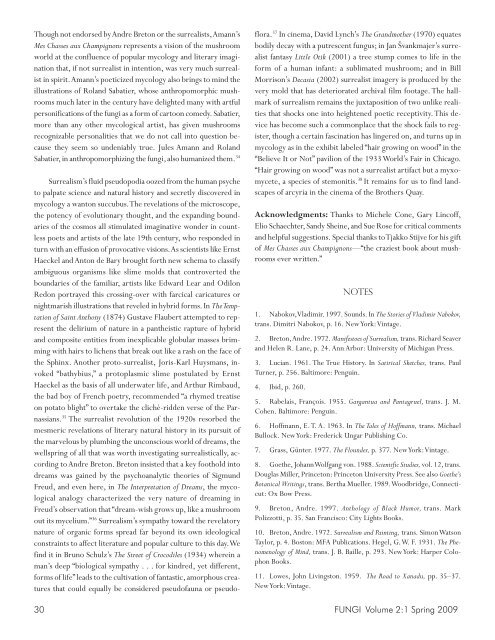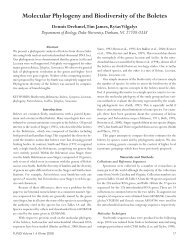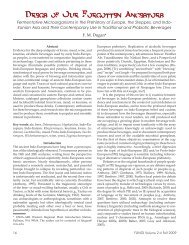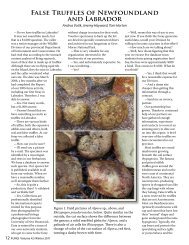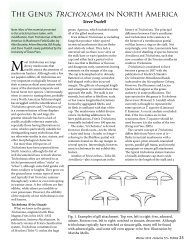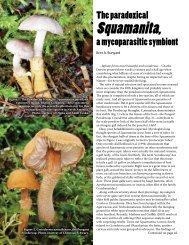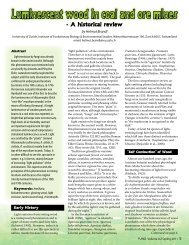Notes from Under- ground - FUNGI Magazine
Notes from Under- ground - FUNGI Magazine
Notes from Under- ground - FUNGI Magazine
Create successful ePaper yourself
Turn your PDF publications into a flip-book with our unique Google optimized e-Paper software.
Though not endorsed by Andre Breton or the surrealists, Amann’s<br />
Mes Chasses aux Champignons represents a vision of the mushroom<br />
world at the confluence of popular mycology and literary imagination<br />
that, if not surrealist in intention, was very much surrealist<br />
in spirit. Amann’s poeticized mycology also brings to mind the<br />
illustrations of Roland Sabatier, whose anthropomorphic mushrooms<br />
much later in the century have delighted many with artful<br />
personifications of the fungi as a form of cartoon comedy. Sabatier,<br />
more than any other mycological artist, has given mushrooms<br />
recognizable personalities that we do not call into question because<br />
they seem so undeniably true. Jules Amann and Roland<br />
Sabatier, in anthropomorphizing the fungi, also humanized them. 34<br />
Surrealism’s fluid pseudopodia oozed <strong>from</strong> the human psyche<br />
to palpate science and natural history and secretly discovered in<br />
mycology a wanton succubus. The revelations of the microscope,<br />
the potency of evolutionary thought, and the expanding boundaries<br />
of the cosmos all stimulated imaginative wonder in countless<br />
poets and artists of the late 19th century, who responded in<br />
turn with an effusion of provocative visions. As scientists like Ernst<br />
Haeckel and Anton de Bary brought forth new schema to classify<br />
ambiguous organisms like slime molds that controverted the<br />
boundaries of the familiar, artists like Edward Lear and Odilon<br />
Redon portrayed this crossing-over with farcical caricatures or<br />
nightmarish illustrations that reveled in hybrid forms. In The Temptation<br />
of Saint Anthony (1874) Gustave Flaubert attempted to represent<br />
the delirium of nature in a pantheistic rapture of hybrid<br />
and composite entities <strong>from</strong> inexplicable globular masses brimming<br />
with hairs to lichens that break out like a rash on the face of<br />
the Sphinx. Another proto-surrealist, Joris-Karl Huysmans, invoked<br />
“bathybius,” a protoplasmic slime postulated by Ernst<br />
Haeckel as the basis of all underwater life, and Arthur Rimbaud,<br />
the bad boy of French poetry, recommended “a rhymed treatise<br />
on potato blight” to overtake the cliché-ridden verse of the Parnassians.<br />
35 The surrealist revolution of the 1920s resorbed the<br />
mesmeric revelations of literary natural history in its pursuit of<br />
the marvelous by plumbing the unconscious world of dreams, the<br />
wellspring of all that was worth investigating surrealistically, according<br />
to Andre Breton. Breton insisted that a key foothold into<br />
dreams was gained by the psychoanalytic theories of Sigmund<br />
Freud, and even here, in The Interpretation of Dreams, the mycological<br />
analogy characterized the very nature of dreaming in<br />
Freud’s observation that “dream-wish grows up, like a mushroom<br />
out its mycelium.” 36 Surrealism’s sympathy toward the revelatory<br />
nature of organic forms spread far beyond its own ideological<br />
constraints to affect literature and popular culture to this day. We<br />
find it in Bruno Schulz’s The Street of Crocodiles (1934) wherein a<br />
man’s deep “biological sympathy . . . for kindred, yet different,<br />
forms of life” leads to the cultivation of fantastic, amorphous creatures<br />
that could equally be considered pseudofauna or pseudo-<br />
flora. 37 In cinema, David Lynch’s The Grandmother (1970) equates<br />
bodily decay with a putrescent fungus; in Jan Švankmajer’s surrealist<br />
fantasy Little Otik (2001) a tree stump comes to life in the<br />
form of a human infant: a sublimated mushroom; and in Bill<br />
Morrison’s Decasia (2002) surrealist imagery is produced by the<br />
very mold that has deteriorated archival film footage. The hallmark<br />
of surrealism remains the juxtaposition of two unlike realities<br />
that shocks one into heightened poetic receptivity. This device<br />
has become such a commonplace that the shock fails to register,<br />
though a certain fascination has lingered on, and turns up in<br />
mycology as in the exhibit labeled “hair growing on wood” in the<br />
“Believe It or Not” pavilion of the 1933 World’s Fair in Chicago.<br />
“Hair growing on wood” was not a surrealist artifact but a myxomycete,<br />
a species of stemonitis. 38 It remains for us to find landscapes<br />
of arcyria in the cinema of the Brothers Quay.<br />
Acknowledgments: Thanks to Michele Cone, Gary Lincoff,<br />
Elio Schaechter, Sandy Sheine, and Sue Rose for critical comments<br />
and helpful suggestions. Special thanks to Tjakko Stijve for his gift<br />
of Mes Chasses aux Champignons—“the craziest book about mushrooms<br />
ever written.”<br />
<strong>Notes</strong><br />
1. Nabokov, Vladimir. 1997. Sounds. In The Stories of Vladimir Nabokov,<br />
trans. Dimitri Nabokov, p. 16. New York: Vintage.<br />
2. Breton, Andre. 1972. Manifestoes of Surrealism, trans. Richard Seaver<br />
and Helen R. Lane, p. 24. Ann Arbor: University of Michigan Press.<br />
3. Lucian. 1961. The True History. In Satirical Sketches, trans. Paul<br />
Turner, p. 256. Baltimore: Penguin.<br />
4. Ibid, p. 260.<br />
5. Rabelais, François. 1955. Gargantua and Pantagruel, trans. J. M.<br />
Cohen. Baltimore: Penguin.<br />
6. Hoffmann, E. T. A. 1963. In The Tales of Hoffmann, trans. Michael<br />
Bullock. New York: Frederick Ungar Publishing Co.<br />
7. Grass, Günter. 1977. The Flounder, p. 377. New York: Vintage.<br />
8. Goethe, Johann Wolfgang von. 1988. Scientific Studies, vol. 12, trans.<br />
Douglas Miller, Princeton: Princeton University Press. See also Goethe’s<br />
Botanical Writings, trans. Bertha Mueller. 1989. Woodbridge, Connecticut:<br />
Ox Bow Press.<br />
9. Breton, Andre. 1997. Anthology of Black Humor, trans. Mark<br />
Polizzotti, p. 35. San Francisco: City Lights Books.<br />
10. Breton, Andre. 1972. Surrealism and Painting, trans. Simon Watson<br />
Taylor, p. 4. Boston: MFA Publications. Hegel, G. W. F. 1931. The Phenomenology<br />
of Mind, trans. J. B. Baille, p. 293. New York: Harper Colophon<br />
Books.<br />
11. Lowes, John Livingston. 1959. The Road to Xanadu, pp. 35–37.<br />
New York: Vintage.<br />
30 <strong>FUNGI</strong> Volume 2:1 Spring 2009


